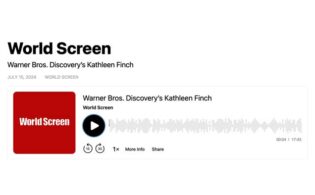Kathleen Finch, the chairman and CEO for U.S. networks at Warner Bros. Discovery (WBD), discussed what’s driving viewership at the channel brands she oversees at the TV Real Festival.
In her session with TV Real’s Kristin Brzoznowski, which you can view here, Finch discussed the market-leading bouquet of networks WBD operates in the factual space, including Investigation Discovery (ID) and TLC.
“When we schedule our very specific genre-based networks—like Food Network, TLC or ID—we will stack a show that is very similar in nature over and over, knowing that our length of tune can sometimes be two or three hours because the content is just so addicting,” Finch said. “We know we have these super fans. We really try to super-serve those fans with a lot of content that is sometimes very iterative of other hits that they love. In a way, it’s comfort food. We’re making about 3,000 hours of content a year. We have figured out what our audiences want from our various genres. So, when we find something that works, we will double down on it, because those super fans will come back for more.”
Finch pointed to the ratings success of many of the services in her portfolio. “On any given night, at least 30 percent of people watching cable are watching our networks—sometimes it’s over 50 percent. The ability to talk to such a large group of viewers at one time gives us all kinds of flexibility to move content around and promote back and forth. On some of our smaller networks, if we have a show that we think could really benefit from a bigger audience, we can move it to a bigger network. We did that with Ghost Adventures, a fun paranormal show. It was doing very well on Travel Channel, but we were able to move it to Discovery Channel, which has a much bigger audience.”
The scale of the WBD portfolio also allows for cross-promotion, Finch continued, referencing the HGTV launch of Barbie Dreamhouse Challenge ahead of the release of the Barbie film. “It gives us an opportunity to dip into the great talent pool and IP that Warner Bros. Discovery has. We announced a Harry Potter Food Network baking competition show. We never could have done that before our merger. But now that Harry Potter is in the family, we have an opportunity to lean in and create new IP for fans of both the Food Network and Harry Potter. It’s really exciting to have all these different things at our disposal and put all these creative minds together and see how we can really maximize them for the viewers.”
On consumption differences across pay and streaming, Finch said, “The audience for Max is about 20 or even 30 years younger than the audience coming to our linear networks. When we premiere a show on linear, we get one audience that watches it, but then when we stream it on Max, we get another audience that watches it. We had a big hit recently that really benefited from this two-audience strategy: Quiet on Set, a true-crime series produced by the ID team. We aired it on ID, then we immediately streamed it on Max. Over 23 million people viewed the show, and it was almost a fifty-fifty split between linear viewers and Max viewers. But what we got on Max was a much younger demographic, and what we got on linear was an older demographic, so we were able to touch millions of people with this show that we would not be able to do if it just was on Max or it just was on ID.”
Finch then talked about the importance of innovation and tapping into social media fandoms as part of her teams’ programming remits. “We are pushing the boundaries to make sure that even the formatted shows don’t look just like traditional studio formatted shows. We’re also getting creative with our spin-offs, being careful to make sure that we don’t overdo a franchise. In the true-crime space, one of the ways that we keep reinventing is we’re going for big, buzzy, loud opportunities, oftentimes featuring people that we know. We have Fallen Idols: Nick and Aaron Carter, Spacey Unmasked, The Playboy Murders. We go with either a brand or a face that people know and then build a story around them because those are the kinds of shows that self-market. It’s [about] always finding ways that will get in front of an audience in a new way, in a different way—still staying true to the genre, but finding a way to get a new hook, a new interest, a new audience to sit up and pay attention.”
Brzoznowski then asked Finch about the qualities she looks for in evaluating projects. “Everything that we do has to stick out,” Finch said. “It’s got to be loud. It’s got to be buzzy. It’s got to have a hook. People have to care about it. Somebody has to look interesting. There’s a lot at stake because the competition is everything; it’s not just other television shows. The competition is gaming and social media and whatever it is somebody else might want to do to take their attention away at 9 o’clock from what I want them to do, which is sit in front of one of my shows. We have to make them big and different and fun. I really do believe in the ‘it factor.’ I don’t think you can teach someone to be telegenic; you are either born that way or not. You can teach them to be better on television, but they have to have that bigger-than-life sparkle. That’s the needle-in-a-haystack part. One of the things that my team and I find the most fun is we don’t necessarily call an agent to find our talent. We find our talent in unusual places because, for the most part, they are doing something in a career that we then want to build a television show around. We are looking for people who are just living their authentic lives, and then we will make a television show around them. It actually makes the hunt for new talent a lot more exciting. And when somebody hits, it’s like gold. It’s probably the hardest part of our job but probably the most rewarding part too.”
 TVREAL
TVREAL






